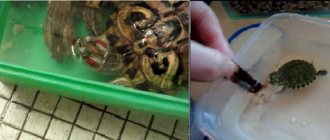Photo Credit To David Mark from Pixabay
Owners of turtles often face the problem of transporting the animal. This could be moving to another city, country, or simply delivering the reptile home. Of course, it is better to transport the turtle in a special carrier, which can be purchased at almost any pet store. This article contains information on how to transport a turtle by any type of transport and at any time of the year.
Transporting a red-eared turtle
From time to time you may need to transport your red-eared turtle somewhere by car (for example, if you go out of town or move).
This move can be extremely stressful for your reptile, but if you put a little time and effort into planning and preparing for the process, chances are the process will go fairly smoothly. Shipping box
For traveling in the car, the turtle can be placed in a plastic box (for example, for storing food). You should make several holes in the lid of the box for ventilation, but make sure that the box is tightly closed during the entire move, as sometimes turtles make masterful escapes. At the bottom of the box you need to put something soft, for example, a rag or towel (it is important that there are no loose threads on them, in which the turtle's claws can get tangled), or paper towels or newspaper. The box should be spacious enough, but not too big: after all, our task is to make the turtle comfortable and soft, and to feel confident throughout the trip.
What about water? Even red-eared turtles, which spend most of their time in water, can survive without it for some time. But if you have a long trip ahead, you can spray the turtle with water (remember - this can only be done if the car is warm). You can also offer the turtle something to drink.
Air Temperature This is the biggest challenge you will face. Place a thermometer in the turtle's box to monitor the temperature. If you're traveling during the warmer months, there are several options to keep your pet from overheating. You can regularly spray the turtle with water or wet the bedding: the evaporation of water will have a cooling effect. If your car has air conditioning, you can turn it on, but be careful not to place the box directly under the cold air and make sure your pet doesn't get hypothermic. Never put ice or anything cold directly into your turtle's box! If you are transporting your turtle in cool weather, you can place the box with it in a sealed cooler bag and place a heating pad next to the box. But again, don't put the heating pad directly into the box!
Ventilation If you have made holes in the box, this will most likely be sufficient. However, during long trips, it is better to periodically open the turtle's box to air it out.
Food Since turtles can easily go several days without food, you can feed your pet a day before departure. In this case, the animal will not defecate in the box and you will not have to feed it during the move (unless your trip is for several days).
Overnight at a hotel If you need to stay overnight at a hotel, make sure in advance that the establishment you choose is pet-friendly.
Bring a small plastic basin with you so you can put it in the bathtub and fill it with water to give your turtle a chance to swim. Please be considerate of housekeepers and other hotel guests by keeping your turtle out of the bathtub or sink itself, or roaming around the room to prevent the spread of salmonella bacteria. When you get ready for the trip in the morning, you can simply pour the water from the basin with the turtle into the toilet. All surfaces touched by the turtle should be wiped with antibacterial wipes.
Awakening after hibernation
After about 3 to 4 months of hibernation, the turtle should wake up on its own. If this does not happen, then you should remove the animal from the box and place it in a terrarium, having previously raised the temperature in it to 20 - 22C. You can also leave the turtle in the box, but move it to a room at room temperature.
Once your turtle is awake and moving around on its own again, the following steps need to be taken. The first step is to bathe the animal in cool water with a temperature of 24 to 26C. At the same time, the turtle must drink a lot, restoring the water balance in the body. After this, place it in the terrarium, turn on the lights and offer fresh food. In the first days after hibernation, the turtle may consume a minimal amount of food, but this is normal.
Features of transporting turtles in the cold
- Land turtles. Can be transported for no more than 3 days. Transportation is carried out without a feeder or drinking bowl.
- Amphibians (red-eared, swamp). Can be transported for no more than 2 days. Transportation is carried out without a feeder and without a drinking bowl.
- Aquatic turtles (Trionix). Can be transported for no more than 1 day. It is imperative to use napkins or towels soaked in water. Transportation without a feeder and drinking bowl is allowed.
- In a special container. An excellent container option is a plastic tray with a transparent lid. An atmospheric thermometer must be attached to the lid. The walls of the tray should have holes for good ventilation. The base of the container needs to be lined with a towel.
- Bosom. You need to wrap your pet in a towel and place it upside down in the inner pocket. Please note that the storage pocket must be ventilated, especially if the reptile is transported for 10 minutes or longer.
- Inside the car. If you transport a turtle in the winter inside a car, you can use a tray without a lid. It is better to cover the bottom of the container with a towel.
Preparation for transportation
If the turtle will be transported for 3 hours or more, then a day before transporting the pet you need to stop feeding and drinking. If the turtle is transported for a day or more, then a week before the trip the pet should be put on a diet (feed a little at a time), and the pet should not be fed or watered at all the day before transportation.
If turtles are being transported, you can use the following as a heating pad:
- A medical heating pad with hot water, enough heat for 1-3 hours
- An ordinary plastic bottle with hot water, enough heat for 1 hour
- A heating pad with a supersaturated saline solution (salt heating pad), the heat will last for 3-8 hours
Transportation methods
During winter weather, you need to provide the turtle with a warm atmosphere. You can use your own body, a heating pad, or a car interior heater as a heat source. Transportation of turtles should be carried out at temperatures from +18° (C) and above. It is undesirable to allow the atmosphere to cool below +15° (C).
The heating pad must be wrapped in a towel. It is better not to allow the turtle to overheat. It is necessary to create conditions so that the turtle itself gets to the heating pad at the distance it needs.
Before transporting turtles, it is better to clean the pets.
It is better to transport each turtle in a separate tray.
Brief instructions
- Prepare the turtle for transportation. Limit food without denying water. Transporting a turtle on an empty stomach will be much smoother.
- Prepare a container suitable to become a temporary home for the turtle. It’s better to use a plastic container, since a cardboard box can get wet and tear due to the reptile’s constant attempts to break free.
- Cover the bottom of the container with a thick layer of paper or sawdust. In cool weather, it is advisable to place a heating pad in the container. Hypothermia has consequences for the turtle's health.
- Place the reptile in the prepared container, fill the remaining empty volume with soft paper to avoid hitting the walls. Cover with a lid to allow air access.
- If you transport sea turtles over long distances, be sure to transport them in containers with water!
Note!
- Hypothermia and drafts are unacceptable.
- A turtle can be kept without food and liquid for no more than 2 days. If the journey is longer, provide access to water.
- If several animals need to be transferred, it is advisable to place them in separate containers.
- If the animal is transported by public transport outside the region, be sure to stock up on a certificate, which can be obtained at any state veterinary hospital.
- To transport reptiles across the border, you must obtain a special permit.
Based on materials from: profivet.ru
Transport your beloved pets carefully and do not forget that we are responsible for those we have tamed. Don't forget how to transport turtles correctly.
Transportation of turtles around the city, veterinary certificate f.4
When keeping reptiles, sometimes you have to deal with the need to transport them. Transportation is a complex undertaking, and if done incorrectly, it can lead to undesirable consequences and even the death of animals. Therefore, before transporting reptiles, it is necessary to pay attention to the condition of the animals, their preparation for it, as well as the selection of transportation containers, taking into account the travel time and transportation conditions. In the summer there are no problems with transportation - I put the turtle in a box and took it wherever needed, but in cold weather the turtle needs to be warmed. This could be a heating pad or human warmth. Transporting turtles over long distances is even more difficult - you must take into account that the turtle will scratch, defecate, and also want to eat and drink. It is necessary to take into account that there is no hypothermia or overheating.
Transporting turtles around the city or outside the city in summer
In summer, terrestrial and semi-aquatic turtles (red-eared, marsh, etc.) can be carried in any plastic containers or cardboard boxes (for example, shoe boxes) with sawdust, wood chips, hay or crumpled toilet paper/soft towels without water for no more than 2 times days.
The turtle can be placed in a plastic or cardboard box, storage container, or a special plastic carrier with ready-made ventilation. If you use a regular container or cardboard box with a lid, you need to think about ventilation. Holes can be drilled independently in the lid of such a box or on the sides. We need to make sure our carrier container closes well, as turtles can be adept at escaping. Place a good layer of bedding at the bottom of the container, such as: a towel (but avoid fabric with loose threads or loops that could entangle the turtle's claws), paper towels or napkins, sphagnum moss, sawdust, wood chips, meadow hay, absorbent wipes . The carrier should be spacious for the turtle, but not give the turtle a lot of room to move around (the goal is to transport the turtle in comfortable conditions and make the move safe.) If several turtles need to be transported, each one is placed in a separate carrier so that they do not injured each other. If the transport is hot and the temperature is above 27-28 degrees, you can put a small piece of cloth or napkin soaked in water in the container, or sometimes spray the turtle (not with cold water). To avoid overheating, in hot summer weather, you can place a thermometer in the carrier, which will allow you to check the temperature without opening the lid of the carrier. Check your pet's temperature and condition regularly. To make sure that it does not roll over, and also to remove waste that may be present, since during the journey, the turtle may defecate. Keep the carrier out of direct sunlight. Make sure that the turtle does not overheat or overcool. Do not leave your turtle carrier in a sunny or drafty place.
How to find a turtle in the house
If it is 100% certain that the turtle has escaped but is still in the house, then you can take the following steps:
First you need to examine nearby hard-to-reach places located in the immediate vicinity of the terrarium. If the fact of her disappearance was discovered shortly after she fled, then she could not have gone far. You should inspect very carefully all hard-to-reach places, namely: the place under the sofa, under the closet, as well as various horizontal and vertical cracks. She is able to climb into any gap if the size of the gap allows it. If cabinets or cabinets were left open, then it will certainly end up there. This animal likes to hide in such places, away from human eyes.
- If this does not help, you will have to turn off the TV, radio, music, etc. to create conditions with ideal silence. In such conditions, if you listen carefully, you can catch the slightest rustling sounds made by the animal. If a turtle is stuck somewhere, it will certainly make characteristic sounds.
- When moving around the house, you need to be very careful, otherwise you can simply step on the animal and crush it. Until the animal is found, you should not calm down.
- The task can be simplified if you place a container of water and a bowl with its delicacy in the middle of the room. Animals have a well-developed sense of smell, and she will certainly try to taste something tasty or drink some water when she gets hungry. To find the place where the animal is, just scatter flour or chalk near food and water. This will help if it is not possible to regularly check if the turtle has approached the food. She will definitely leave traces behind.
- Alternatively, you can install and turn on a table lamp in the center of the room, especially if the apartment is cool. A turtle, sensing a warm place, will certainly want to bask. In addition, you can sprinkle flour or chalk.
- If there are other animals in the house, especially dogs, it is enough to monitor the behavior of the animal. As a rule, the dog never makes a mistake and leads to a fugitive.
- Just in case, it doesn’t hurt to ask your neighbors if they have seen the turtle if you couldn’t find it in the house.
Transportation of red-eared turtles in the warm season
In summer, any container of suitable size will be suitable for transporting red-eared turtles. You can use a fairly strong box (for example, a shoe box), at the bottom of which it is recommended to put fabric, sawdust, or crumpled toilet paper. Air access must be ensured in such an improvised temporary housing. To do this, make several coin-sized holes in the box. To prevent the red-eared cat from chattering on the road, it is recommended to place crumpled sheets of paper around it. In the case of transporting several individuals, it is better to prepare such a “temporary house” for each of them. Turtles can be transported in a box if the trip lasts no more than a day. Although the reptile spends most of its life in an aquatic environment, it is able to do without its usual habitat for some time.
You can find carriers for turtles in pet stores. They are made of plastic, so cleaning such a carrier after a trip will not be difficult. If you often have to transport turtles, it makes sense to purchase such a carrier.
How to transport a red-eared slider over long distances
If there are no particular difficulties with transportation over short distances, especially in the warm season, then transporting red-eared fish over long distances is much more difficult. Be prepared for the fact that the animal will scratch, want to eat and drink, and fulfill its natural needs. In addition, hypothermia or, conversely, overheating is unacceptable.
The animal must be prepared for transportation. Do not feed your turtle for two days before your trip. The temperature in the aquarium should be at normal levels. This is done to empty the intestines.
If you and your turtle have a very long trip ahead, it is best to use a special transportation aquarium made of durable glass. In such an aquarium, it is important to maintain a normal water temperature for the pet. If it is not possible to create an island of land, do not forget to periodically pick up the animal.
Upon arrival, place the turtle in its home (aquarium or aquaterrarium). But not immediately into the water, but onto an island of land, so that the turtle does not swallow water into its lungs from stress. Do not disturb your pet for several hours either with your presence near the aquaterrarium or with sharp sounds. Let him be alone quietly and look around the new place. After 3 hours you can offer the red ear food, but it is not a fact that it will eat. It may take several days to adapt.
Filling the aquaterrarium
The larger the area of the turtle's home, the more opportunities for creating beautiful decor.
Stones are usually placed at the bottom of the aquarium; you can buy colored stones for aquariums - but be sure to choose all of them that are smaller in size than your pet’s head, so that he does not swallow them and choke. Sturdy shells without sharp edges also look great. Turtles love to dig and dig, turn over and drag everything that gets into their aquarium. Even plastic algae, usually sold with a base, can be easily peeled off. Therefore, it will not be possible to arrange a beautiful, neat landscape - the turtle will quickly arrange everything the way it likes.
In this regard, it is better to place on the bottom either something that can be easily moved and that changing places will not affect the overall appearance - for example, stones, shells and pieces of glass, or large objects that cannot be moved. These can be special driftwood, inside of which, by the way, you can hide a heater, or ceramic elements. You should not buy hollow snags and caves; the turtle can climb into them while it is small, however, it is just as likely to get stuck there.
You can glue photo wallpaper to the back of the aquarium. It is useless to plant algae near turtles; very soon they will be torn out and most likely eaten. However, in general, placing them in the aquarium is a good idea, but they are specifically edible and tasty for the turtle to enjoy. Those that float on the surface are most suitable.











